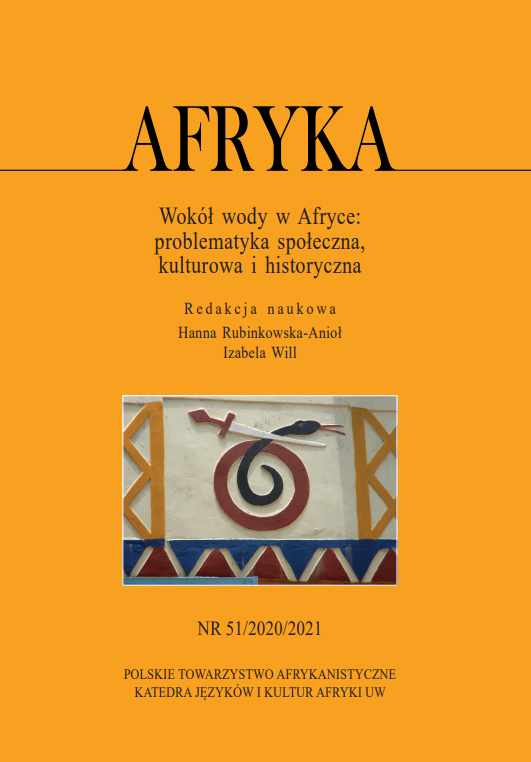Artykuły
Abstract
Like the majority of African countries, contemporary Kenya is a mosaic of cultures and languages shaped throughout the centuries. The Akamba discussed in this article live in the Machakos County and are one of the most numerous ethnic groups in Kenya. Amongst the many characteristics of their culture, the ones most relevant to the topic are: collectivism, avoidance of uncertainty, hierarchy, orientation towards the future (long-term orientation), variety of traditionally undertaken tasks. These characteristics of their culture have influence for adaptability to the changing and difficult living conditions: in this case, thanks to the methods of obtaining water and the ways to store and protect it.
References
- Barth, Frederik. 1969. „Introduction”, w: F. Barth (red.), Ethnic group and boundaries: The social organization of culture difference. Oslo: Universitesforlaget, 9–38.
- Farmbiz Africa. 2018. Water harvesting save an 84 years of Machakos farmer as speer suffer drought during, 26 November 2018, https://farmbizafrica.com/profit-boosters/10-smart-farms/2433-water-harvesting-saves-an-84-years-old-machakos-farmer-as-peerssuffer-during-drought, dostęp z dnia 20 lutego 2021.
- Feierman, Steven. 2003. „Ludność i języki w krajach Afryki Wschodniej w czasach najdawniejszych”, w: P. Curtin et al. (red.), Historia Afryki. Gdańsk: MARABUT.
- Gichuki, Francis N. 1991. Environmental change and dryland management in Machakos district, Kenya 1930–90. Conservation Profile. London: Overseas Development Institute, Regent’s College; Nairobi: University of Nairobi/Ministry of Reclamation and Development of Arid, Semi-Arid Areas and Wastelands; https://www.odi.org/sites/odi.org.uk/files/odi-assets/publications-opinion-files/6951.pdf, dostęp z dnia 10 lutego 2021.
- Hobley, C. W. 2010. Ethnology of A-Kamba and other East African tribes. Cambridge: Cambridge University Press.
- Hofstede, Geert. 1980. Culture’s consequences: International differences in work-related values, 2nd SAGE Publication. http://study.com/academy/lesson/hofstedes-uncertaintyavoidance-index-definition-example-cultures.html, dostęp z dnia 15 września 2020.
- Hofstede, Geert. 2011. „Dimensionalizing Cultures: The Hofstede Model in Context”. Online Readings in Psychology and Culture 2, 1, https://scholarworks.gvsu.edu/cgi/viewcontent.cgi?article=1014&context=orpc, dostęp z dnia 15 września 2020.
- Kiereini, Douglas. 2019. „Yatta Furrow: Where a Colonial Legacy Now Feeds Villages”. Bussines Daily, 28 FEBRUARY 2019, https://www.businessdailyafrica.com/bd/lifestyle/society/yatta-furrow-where-a-colonial-legacy-now-feeds-villages-2240690, dostęp z dnia
- października 2020.
- Kithiia, Shadrack Mulei. 1997. „Land use changes and their effects on sediment transport and soil erosion within the Athi drainage basin, Kenya”, IAHS Hydrological Sciences Journal 245, 145–150.
- Krajewski, Marek; Agata Skórzyńska (red.). 2017. Diagnoza w kulturze. Warszawa: Narodowe Centrum Kultury.
- Machakos Cooperativ Union 2020, https://www.mcultd.co.ke/ , dostęp z dnia 20 listopada 2020.
- Mani, Joseph M. 2019. „Cultural patterns from the Kamba culture”, niepublikowany artykuł, https://www.academia.edu/1244095/CULTURAL_PATTERNS_FROM_THE_KAMBA_CULTURE?auto=download, dostęp z dnia 01 września 2020.
- Mendes, Diego M., Lisa Paglietti. 2015. „Kenya irrigation market brief”, http://www.fao.org/3/a-i5074e.pdf, dostęp z dnia 10 października 2020.
- Ministry of Water and Sanitation. 2018. Ministry of Water and Sanitation Executive Brief on Water Supply Status in Machakos County 17th July 2018, http://tanathi.go.ke/preports/Machakos%20County%20Projects.pdf , dostęp z dnia 12 października 2020.
- Muraya, Joseph. 2017. „It’s not in doubt that with the right plans, a dry area such as Machakos can also produce sufficient food”, The Capital FM News. Nairobi, Kenya, July 3, 2017, https://www.capitalfm.co.ke/news/2017/07/water-projects-change-the-faceof-machakos-county/, dostęp z dnia 10 października 2020.
- Mwangangi, Joseph. 2019. „Census results for Ukambani Counties”, Mauvoo News, November 4, https://mauvoo.com/2019-census-results-for-ukambani-counties/, dostęp z dnia 19 września 2020.
- Ocharo, Robinson M.; Lucy M. Kithu. 2020. „Social predictors of food insecurity: The case of Yatta Constituency, Machakos County, Kenya”. Current Research Journal of Social Sciences 3, 1, 86–95.
- Parsons, Timothy. 2012. „Being Kikuyu in Meru: Challenging the tribal geography of colonial Kenya”, Journal of African History, 53, 65–86.
- Rakowski, Tomasz; Agata Skórzyńska. 2017. „Metodologie i ujęcia”, w: M. Krajewski, A. Skórzyńska (red.), Diagnoza w kulturze. Warszawa: Narodowe Centrum Kultury, 25–66.
- Rocheleau, Dianne; Patricia Benjamin; Alex Diang’a. 1995. „The Ukambani region of Kenya”, w: Jeanne X. Kasperson, Roger E. Kasperson, B. L. Turner II (red.), Regions at risk: comparisons of threatened environments. Tokyo-New York-Paris: United Nations University Press.
- TANATHI Water Works Development Agency (TAWWDA). 2020. https://tanathi.go.ke/index.php/recent-projects/ongoing-projects, dostęp z dnia 12 października 2020.
- Tiffen, M.; M. Mortimore; F. Gichuki. 1994. More people less erosion: Environmental recovery in Kenya. Nairobi: ACTS Press.
- Töpfer, Klaus; James D. Wolfensohn; Jonathan Lash. 2000. „Regaining the Gigh Ground. Reviving the Hill Side of Machakos”, w: A guide to world resources 2000-2001. People and ecosystems. The fraying web of life. Washington, D.C.: World Resources Institute, 149–162.
- UN Cartographic Section. 2020. https://www.nationsonline.org/oneworld/map/kenya_map2.htm, dostęp z dnia 20 sierpnia 2020.
- Vorbrich, Ryszard. 2012. Plemienna i postplemienna Afryka. Poznań: Wydawnictwo Naukowe UAM.
- Wamochie, Ryszard. 2020. „360 water pans completed in Yatta for irrigation”, The Star, 28 May 2020.
- Wangũhũ Ng’ang’a. 2006. Kenya’s ehnic communities. Foundation of the nation. Nairobi: Gatũndũ Publisher’s Limited.
- Wasreb 2020. The Water Services Regulatory Board, https://wasreb.go.ke/about-us, dostęp z dnia 10 października 2020.
- World Resources. 2000–2001. „Regaining the high ground: Reviving the Hill Sides of Machakos”, 145–158, http://pdf.wri.org/wr2000_agroecosystems_machakos.pdf, dostęp z dnia 20 grudnia 2020.
